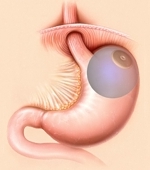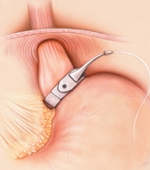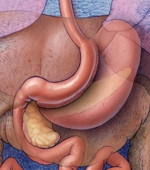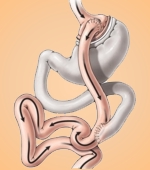 |
 |
 |
 |
 |
|
Bariatric Procedures |
Endoscopic Treatment
(Temporary) |
|
Surgical Treatment
(Permanent) |
|
| Type of Procedure |
Intragastric Balloon |
Laparoscopic Adjustable Gastric Banding |
Laparoscopic Sleeve Gastrectomy |
Laparoscopic Gastric Bypass |
 |
 |
 |
 |
 |
| Anatomy |
A 500cc balloon is
inserted through the month into stomach. |
An adjustable silicone
right (band) is placed around the top part of the stomach creating a
small 1-2 ounce (15-30cc) pouch. |
Long narrow vertical
pouch measuring 2-3oz (60-100cc).

No intestinal bypass performed. |
Small 1 ounce pouch
(20-30cc) connected to the small intestine.

Food and digestive
juices are separated for 3-5 feet. |
| |


 |


 |


 |


 |
 |
 |
 |
 |
 |
| Mechanism |
Reduced stomach volume.

Induce satiety. |
Moderately restricts
the volume and type of foods able to be eaten.

Only procedure that is adjustable. Delays emptying of pouch.

Creates sensation of fullness. |
Significantly restricts
the volume of food that can be consumed.

NO malabsorption

NO dumping |
Significantly restricts
the volume of food that can be consumed.

Mild malabsorption.

"Dumping Syndrome" when sugar or fats are eaten. |
 |
 |
 |
 |
 |
| Procedure time |
30 min |
60 - 90 min |
60 - 90 min |
120 - 180 min |
 |
 |
 |
 |
 |
| Average Hospital stay |
0 - 1 day |
2 - 3 days |
4 - 6 days |
7 - 9 days |
 |
 |
 |
 |
 |
| Average weight loss |
loss 10 - 12 kg in 6
months
(BMI ~5 kg/m2 loss) |
loss 20 - 30 kg in 2
years
(BMI ~10 kg/m2 loss) |
loss 25 - 35 kg in 2
years
(BMI ~12 kg/m2 loss) |
loss 30 - 40 kg in 2
years
(BMI ~15 kg/m2 loss) |
 |
 |
 |
 |
 |
Behavioral
Adjustment |
Small meal size

Avoid liquid calories

Regular exercise

Remove in 6 months, able to maintain healthy dietary habit |
Small meal size

Avoid liquid calories

Regular exercise

Follow-up adjustment of band |
Small meal size

Avoid liquid calories

Regular exercise |
Small meal size

Avoid liquid calories & fatty food (dumping syndrome)

Regular medication (vitamin)

Regular exercise |
 |
 |
 |
 |
 |
| Advantage |
No surgery

Reversible |
Low risk surgery

Reversible

Adjustable |
Faster weight loss

No foreign material

No need adjustment |
More effective weight
loss

Better control in diabetes |
 |
 |
 |
 |
 |
| Disadvantage |
Possible weight rebound
after removal balloon (70%) |
Slow weight loss

Less effective in superobese & poor complicance patients

Presence of foreign material

Possible failure & require removal (10%) |
Irrevesible

Slightly higher risk surgery |
Ireverisble

High risk surgery

Need life-long medication

Risk of mal-nutrition |
 |
 |
 |
 |
 |
| Patient Choice |
Not accept / suitable
for surgery

Willing to reduce meal size

Can comply dietary advise |
Accept surgery (lowest
risk) & Presence of foreign implant

Willing to reduce meal size

Can comply dietary advise |
Accept surgery
(moderate risk)

Removal part of stomach

Willing to reduce meal size

Can comply dietary advise |
Accept surgical (higher
risk)

Control severe diabetes

Willing to reduce meal size

Can comply dietary advise |
 |
 |
 |
 |
 |
| Our recommendation |
Lower BMI (< 35
kg/m2)

High operative risk

Can use to loss weight before major surgery |
BMI < 50 kg/m2

More disciplined patients in dietary restriction & exercise
program |
BMI > 40 kg/m2

First stage procedure for superobese (BMI > 60)

Limited long-term result |
High BMI (> 50
kg/m2)

Diabete patients

Second stage procedure for revisional surgery |
 |
 |
 |
 |
 |
